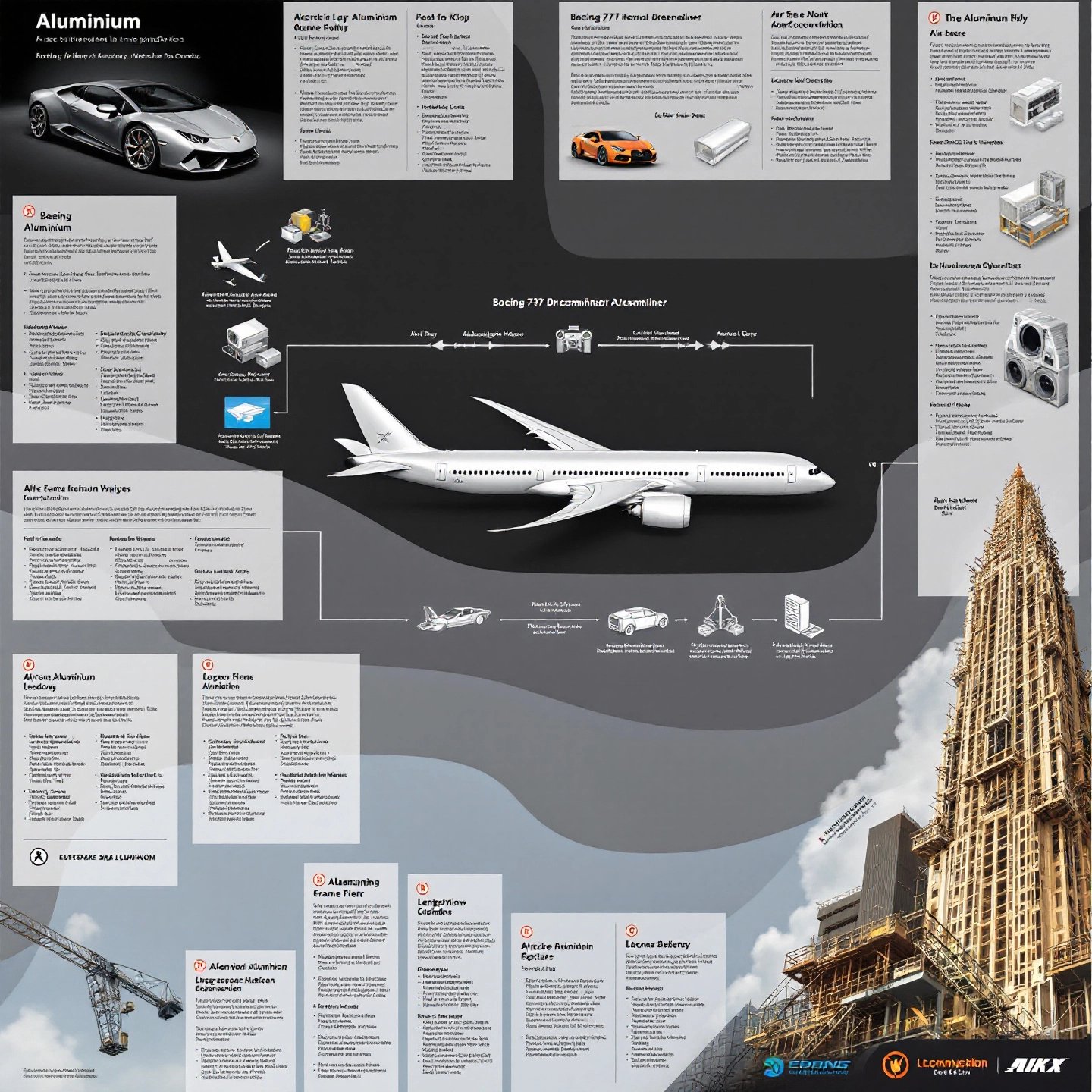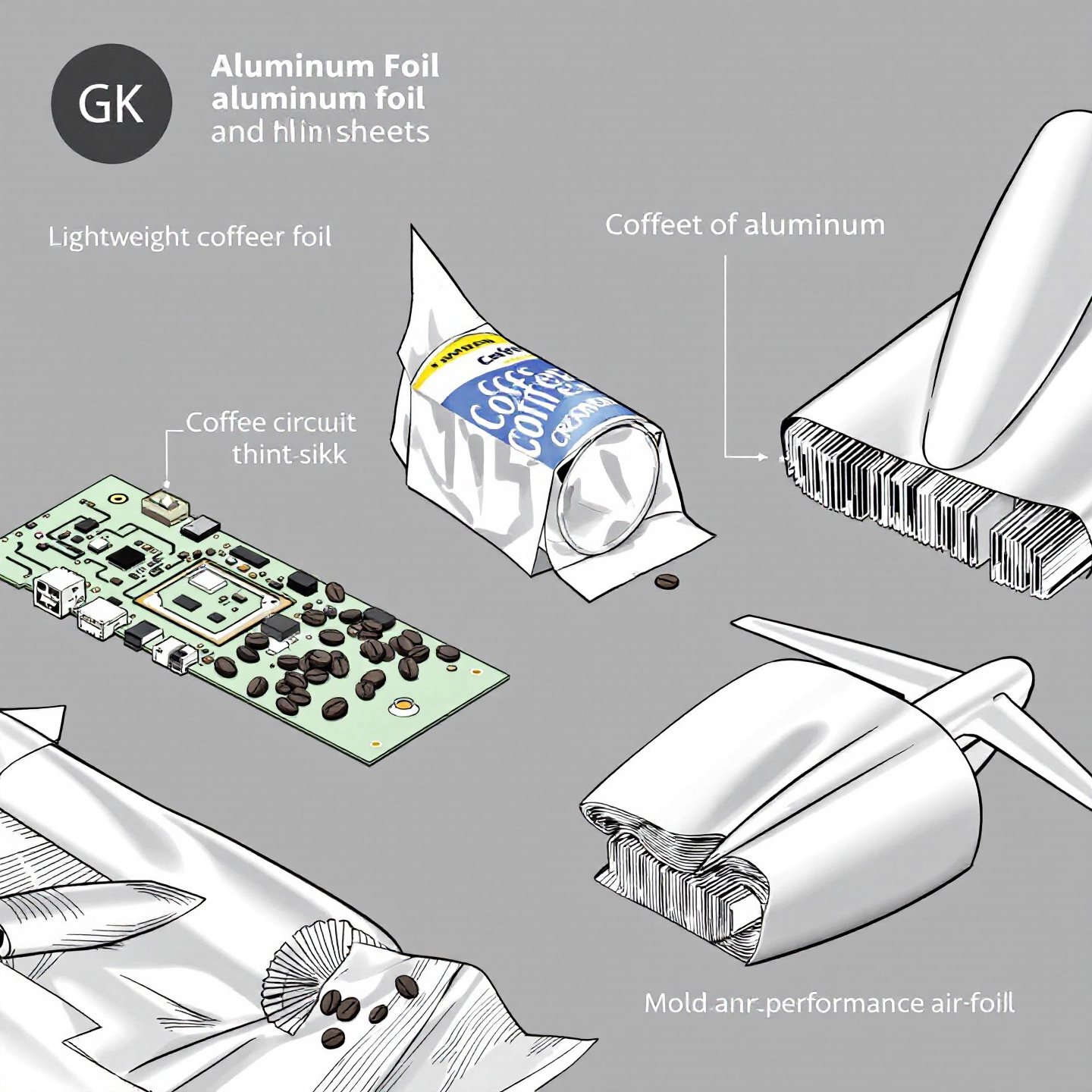
When you think about aluminum, its lightweight nature and versatility probably come to mind. But have you ever wondered what makes aluminum such a popular choice in industries ranging from aerospace to construction? The answer often lies in its density. The density of aluminum is a fundamental property that plays a crucial role in determining how this metal can be utilized effectively.
Density, in scientific terms, is defined as the mass per unit volume of a substance. For aluminum, this value is 2.70 g/cm³. This relatively low density is what gives aluminum its lightweight characteristic, making it an ideal choice for applications where reducing weight is essential. Imagine designing an airplane; every gram saved in materials can significantly impact fuel efficiency and performance. Hence, understanding the mass density of aluminum is vital for engineers and designers who aim to optimize material usage without compromising strength or durability.
Aluminum's density is not just a number; it is a key factor in material selection and design. For instance, in the automotive industry, using aluminum can lead to lighter vehicles, which translates to better fuel economy and reduced emissions. In construction, aluminum's density allows for structures that are both robust and easy to handle.
Moreover, this standard density value is crucial in engineering calculations, such as determining the load-bearing capacity of aluminum components. By knowing the density, engineers can accurately predict how aluminum will behave under different conditions, ensuring safety and reliability in their designs. Thus, the density of aluminum is more than a mere physical property; it is a cornerstone in the practical application of this versatile metal.

So, what exactly is the density of aluminum metal? In scientific terms, density is a measure of how much mass is contained in a given volume. For aluminum, this value is approximately 2.70 g/cm³ or 2,700 kg/m³, as noted in various scientific references. This standard density is pivotal in understanding aluminum’s mechanical and structural properties, influencing everything from material selection to design strategies.
The journey to establishing this density value is steeped in history. Initially, aluminum was a rare and expensive metal, with its density first measured during the 19th century when the metal was isolated and studied extensively. The work of chemists like Hans Christian Ørsted and Friedrich Wöhler in the early 1800s laid the groundwork for understanding aluminum’s properties, including its density. As the metal became more accessible with the development of the Hall–Héroult process in the late 1800s, precise measurements of its density were crucial for its widespread adoption in various industries.
But why is the density of aluminum so significant in engineering calculations? Imagine designing a bridge or an aircraft. Knowing the density of aluminum metal allows engineers to calculate the weight of components accurately, ensuring structural integrity while optimizing for weight efficiency. This is particularly important in aerospace and automotive industries, where reducing weight can lead to improved fuel efficiency and performance.
Moreover, the density of aluminum plays a critical role in determining its behavior under different conditions. For instance, in applications where thermal expansion is a concern, understanding how aluminum’s density changes with temperature is essential for maintaining structural stability. Overall, the density of aluminum is not just a static number; it is a dynamic property that influences a wide range of engineering decisions, ensuring that this versatile metal continues to meet the demands of modern technology.
Understanding the density of aluminum is not only about knowing its value but also about being able to express it in various units, especially when collaborating internationally or engaging in product design. The standard density of aluminum is 2.70 g/cm³, but this can also be expressed in other units such as pounds per cubic inch (lb/in³), which is approximately 0.098 lb/in³. These conversions are crucial for ensuring consistent and accurate communication across different regions and industries.
In scientific and engineering contexts, density is often measured in grams per cubic centimeter (g/cm³) or kilograms per cubic meter (kg/m³). For instance, the density of aluminum in SI units is 2,700 kg/m³. However, in the United States, where the imperial system is more prevalent, density might be expressed in pounds per cubic foot (lb/ft³), equating to approximately 168.5 lb/ft³. Understanding these units is essential for engineers and designers who work on projects spanning multiple countries or industries.
Converting between these units is straightforward with the right formulas. For example, to convert g/cm³ to kg/m³, you simply multiply by 1,000. Conversely, to convert kg/m³ to g/cm³, you divide by 1,000. Converting to imperial units, such as from g/cm³ to lb/in³, requires multiplying by a factor of 0.036127. These conversions are vital for ensuring that calculations remain consistent and accurate, regardless of the unit system used.
In global industries like aerospace and automotive manufacturing, maintaining consistency in unit usage is critical. Imagine collaborating on a project with international partners where different units are used without proper conversion; this could lead to significant errors in design and production. By standardizing units and ensuring accurate conversions, teams can avoid costly mistakes and enhance the reliability of their products.
In conclusion, understanding and converting the density of aluminum g/cm³ and density of aluminum lb/in³ is essential for effective communication and precision in engineering. This knowledge not only facilitates international collaboration but also ensures that designs and products meet the necessary specifications and standards, ultimately leading to better outcomes in material selection and application.

When discussing aluminum alloys, the density of 6061 aluminum stands out due to its widespread use and versatile properties. Known for its excellent mechanical properties and good weldability, 6061 aluminum is a popular choice in industries ranging from aerospace to automotive. But what exactly makes this alloy so special, and how does its density play a role?
The density of 6061 aluminum is approximately 2.70 g/cm³, similar to pure aluminum, but its composition includes magnesium and silicon as major alloying elements. These additions enhance its strength and corrosion resistance, making it suitable for structural applications. The 6061-T6 aluminum lb/ft³ value is around 169 lb/ft³, a critical factor in engineering calculations where weight and strength must be balanced.
The composition of 6061 aluminum can slightly affect its density. Variations in the alloying elements can lead to minor changes in density, which may influence the material's performance in specific applications. For instance, increasing the magnesium content can enhance strength but may slightly alter the density. This sensitivity to compositional changes requires precise control during manufacturing to ensure consistent quality and performance.
6061 aluminum is celebrated for its versatility. It is used in constructing aircraft structures, marine fittings, and even bicycle frames. The alloy's ability to be heat-treated allows it to achieve various temper states, such as T6, which provides an optimal balance of strength and workability. This makes 6061 aluminum ideal for applications requiring high strength-to-weight ratios.
In the context of manufacturing and supply, companies like Shengxin Aluminum play a crucial role. As a leading provider of high-quality aluminum profiles, Shengxin Aluminum ensures that their 6061 aluminum products meet industry standards, providing solutions for diverse engineering needs.
In summary, the density of 6061 aluminum is a key factor in its application across various industries. Its unique composition allows it to maintain a balance between weight and strength, making it a preferred choice for many structural applications. Whether in aerospace, automotive, or construction, understanding and utilizing the properties of 6061 aluminum can lead to innovative and efficient design solutions.
When it comes to aluminum alloys, the density of 5052 aluminum and the density of 7075 aluminum are often compared due to their distinct characteristics and applications. Both alloys serve unique roles in various industries, but their differences in density and composition significantly influence their performance and suitability for specific uses.
The density of 5052 aluminum is approximately 2.7 g/cm³, which is typical for aluminum alloys. This alloy is known for its excellent corrosion resistance and moderate strength, making it ideal for marine environments and applications where durability and resistance to saltwater are crucial. On the other hand, 7075 aluminum has a slightly higher density of about 2.81 g/cm³. This increase in density is due to its higher zinc content, which enhances its strength and makes it one of the strongest aluminum alloys available.
5052 aluminum is primarily composed of aluminum and magnesium, which contributes to its corrosion-resistant properties. Its mechanical properties include a tensile strength of around 190 MPa and good formability, making it suitable for applications like fuel tanks and marine structures. In contrast, 7075 aluminum, with its higher zinc and copper content, boasts a tensile strength of up to 510 MPa in its T6 temper, making it an excellent choice for high-stress applications such as aerospace components and military equipment.
Understanding the density of 5052 aluminum and density of 7075 aluminum is crucial for selecting the right material for the job. The 5052 alloy is often used in industries where corrosion resistance is paramount, such as in marine and automotive applications. Its ability to withstand harsh environments makes it a reliable choice for structures exposed to the elements.
In contrast, 7075 aluminum is preferred in industries where strength-to-weight ratio is critical. Its exceptional strength and relatively low weight make it ideal for aerospace and defense applications, where reducing weight without sacrificing performance is essential. This alloy is commonly used in aircraft frames, high-performance automotive parts, and even in the production of sports equipment like bicycles and climbing gear.
In summary, the choice between 5052 and 7075 aluminum alloys depends largely on the specific requirements of the application. While 5052 offers excellent corrosion resistance and moderate strength, 7075 provides superior strength and durability for high-stress environments. By understanding these differences, engineers and designers can make informed decisions that optimize performance and longevity in their projects.

When you unwrap a chocolate bar or cover a dish for baking, you're likely using aluminum foil. But did you know that the density of aluminum foil plays a crucial role in its functionality? Aluminum foil, with a density ranging from 2.70 to 2.75 g/cm³, is a perfect example of how thickness can influence material properties. This thin yet strong material owes its versatility to its density, which allows it to be lightweight while still providing effective coverage and protection.
Sounds complex? Not really. When you consider thin-gauge aluminum sheets, which typically range from 0.1 mm to 6.0 mm in thickness, you'll notice that their density remains relatively constant, but their applications vary widely. From wrapping food to forming parts in electronics and automotive industries, these sheets are prized for their formability and corrosion resistance. Imagine crafting a lightweight car part or creating a flexible electronic casing; the density of these sheets ensures they are both light and strong enough for a variety of uses.
Thin aluminum sheets are less robust than their thicker counterparts, yet they excel in areas where weight reduction is key. In industries like aerospace and automotive, where every gram counts, these sheets offer an excellent balance of weight and strength, contributing to fuel efficiency and performance. The lighter weight doesn't mean they compromise on durability; instead, they provide flexibility and ease of shaping, making them indispensable in design and manufacturing processes.
Consider the packaging industry, where thin sheets are used to create lightweight, cost-effective packaging solutions. Their ability to resist corrosion and conduct heat makes them ideal for food preservation and cooking. In electronics, thin aluminum sheets are used for heat sinks and casings, benefiting from their excellent thermal conductivity and lightweight nature.
Companies like Shengxin Aluminum are at the forefront of producing high-quality thin aluminum sheets. With advanced production capabilities, Shengxin Aluminum ensures their products meet the rigorous demands of various industries, from automotive to construction, providing solutions that enhance efficiency and sustainability.
In summary, the density of aluminum foil and thin-gauge sheets is a fundamental property that underpins their widespread use across multiple sectors. By understanding how thickness influences applications, industries can leverage these materials to achieve innovative and efficient solutions, ensuring products that are both lightweight and durable.
When deciding between materials for a project, understanding the density of steel vs aluminum is crucial. Aluminum is renowned for its lightweight nature, boasting a density of approximately 2.70 g/cm³, whereas steel is significantly denser, with a density around 7.85 g/cm³. This stark difference in density makes aluminum a preferred choice in weight-sensitive industries such as aerospace, automotive, and construction.
Imagine designing a commercial airplane or a high-performance vehicle. Here, every pound matters. Aluminum's low density translates to a lighter structure, which can lead to improved fuel efficiency and increased payload capacity. This is why aluminum is extensively used in the aerospace industry. For instance, the Boeing 747 is composed of about 80% aluminum, allowing it to maintain a balance between weight and structural integrity.
In the automotive sector, aluminum is increasingly used to reduce vehicle weight, thereby enhancing fuel economy and reducing emissions. The Ford F-150, for example, utilizes military-grade aluminum alloy to shed up to 700 pounds compared to older models, significantly boosting its efficiency.
Despite aluminum's advantages, there are scenarios where steel's higher density and strength are more suitable. In applications where maximum strength is paramount, such as in building foundations or heavy machinery, steel's robustness is unmatched. Its ability to bear heavy loads without deformation makes it ideal for structures where durability and longevity are critical.
Moreover, steel's higher density contributes to its superior acoustic and thermal insulation properties, which are beneficial in certain construction applications. For example, in skyscrapers, steel's strength and density help support the immense weight and stress these structures endure.
In conclusion, the choice between aluminum vs steel applications depends largely on the specific requirements of the project. While aluminum offers significant advantages in terms of weight and corrosion resistance, steel provides unparalleled strength and durability. Understanding these differences allows engineers and designers to select the most appropriate material for their needs, optimizing performance and efficiency in their designs.

Have you ever wondered why aluminum is such an excellent conductor of electricity? The answer lies in its electron density. The electron density of aluminum is a critical factor that influences its conductivity and chemical bonding properties. In simple terms, electron density refers to the distribution of electrons in a material, and in the case of aluminum, it plays a pivotal role in its behavior as a metal.
Aluminum is often described as an "ideal" metal due to its free electron gas model, where valence electrons move freely, contributing to its high conductivity. This characteristic is crucial in applications ranging from electrical wiring to heat sinks. The ability of electrons to move without significant resistance means that aluminum can efficiently conduct electricity, making it a preferred choice in electrical and thermal applications.
Imagine electrons as tiny particles flowing through a metal lattice. In aluminum, the electron density is such that these particles can move with minimal obstruction, facilitating the flow of electric current. This is why aluminum wires are commonly used in power transmission and distribution. The aluminum conductivity is further enhanced by its low density compared to other metals like copper, allowing for lighter and more flexible wiring solutions.
The electron density also affects how aluminum bonds with other elements. Its ability to form strong bonds is due to the redistribution of electrons during chemical reactions. For instance, when aluminum reacts with oxygen, it forms a stable oxide layer that protects the metal from further corrosion. This property is particularly advantageous in industries where durability and longevity are essential, such as in construction and automotive manufacturing.
Furthermore, the electron density influences aluminum's mechanical properties. The bonding electron density correlates with the material's elastic properties, impacting how it deforms under stress. This knowledge is vital for engineers and designers who need to predict how aluminum components will perform under various conditions.
In conclusion, the electron density of aluminum is more than just a scientific concept; it is a fundamental aspect that determines the material's conductivity, chemical bonding, and mechanical properties. By understanding these factors, industries can harness aluminum's full potential, ensuring efficient and innovative applications across a wide range of sectors.
When it comes to understanding the density of aluminum, accurate measurement is paramount. But how do you ensure precision in these measurements? Let's explore some practical density measurement techniques that are widely used in the industry.
One of the most traditional methods is Archimedes’ Principle, which involves submerging an aluminum sample in a liquid of known density. Sounds complex? Not really. Here's how it works:
This method is straightforward and effective, especially for solid samples, providing a reliable way to assess density.
For those requiring more precision, X-ray density measurement offers an advanced alternative. This technique uses X-ray diffraction to determine the lattice parameters of crystalline aluminum, allowing for highly accurate density calculations. The process involves:
This method is particularly useful for research and applications where minute differences in density can impact performance.
Regardless of the method chosen, maintaining consistency is crucial. Imagine the consequences of inaccurate density measurements in engineering calculations; it could lead to flawed designs and structural failures. Therefore, rigorous procedures and regular calibration of equipment are essential to ensure that measurements remain reliable and accurate.
In conclusion, understanding and applying the right density measurement techniques is vital for accurate density assessment. Whether using Archimedes’ Principle for its simplicity or X-ray methods for precision, the key lies in consistency and attention to detail. By mastering these techniques, industries can ensure that aluminum products meet the highest standards of quality and performance.
As we wrap up our exploration of the density of aluminum, it's clear that this property is central to understanding aluminum's versatility and widespread application. From aerospace to consumer electronics, the low density of aluminum, typically around 2.70 g/cm³, allows it to be a lightweight yet strong material suitable for a multitude of uses. This characteristic not only enhances fuel efficiency in vehicles and aircraft but also contributes to robust yet manageable construction materials.
Throughout this article, we've delved into how the density of aluminum influences everything from its mechanical properties to its role in alloy formation. We've seen how specific alloys like 6061 and 7075 leverage density variations to optimize performance in different environments. This understanding is crucial for engineers and designers aiming to select the right material for their projects, ensuring both performance and cost-effectiveness.
Moreover, the significance of density extends to practical applications, such as in the production of aluminum foil and thin sheets, where maintaining a low weight without sacrificing strength is essential. The ability to convert and communicate density measurements across different units further underscores the importance of this property in global engineering and manufacturing contexts.
For those looking to deepen their understanding or seek tailored solutions, consulting with aluminum industry experts can provide invaluable insights. Companies like Shengxin Aluminum exemplify expertise in producing high-quality aluminum profiles that meet diverse industrial needs, from structural components to energy-efficient solutions. Their commitment to quality and innovation ensures that they remain at the forefront of the industry, ready to support projects with precision-engineered aluminum solutions.
In conclusion, the density of aluminum is more than just a scientific measure; it is a gateway to unlocking the potential of this remarkable metal. Whether you're an engineer, designer, or industry professional, understanding aluminum's density and leveraging the expertise of industry leaders like Shengxin Aluminum can drive innovation and success in your projects.
The density of aluminum is approximately 2.70 g/cm³. This low density is a key factor in its widespread use in industries where weight reduction is crucial, such as aerospace and automotive.
Aluminum's low density makes it ideal for applications requiring lightweight materials, such as in aircraft and vehicle manufacturing, where it helps improve fuel efficiency and performance.
Aluminum is preferred in industries like aerospace and automotive due to its lower density, which results in lighter components and improved fuel efficiency, unlike steel which is denser and heavier.
5052 aluminum is known for its corrosion resistance and is used in marine applications, while 7075 is stronger and used in high-stress environments like aerospace, due to its higher density and zinc content.
Electron density affects aluminum's conductivity and bonding properties, making it an excellent conductor for electrical applications and influencing its mechanical strength and corrosion resistance.
 serviço on-line
serviço on-line 0086 136 3563 2360
0086 136 3563 2360 sales@sxalu.com
sales@sxalu.com +86 136 3563 2360
+86 136 3563 2360